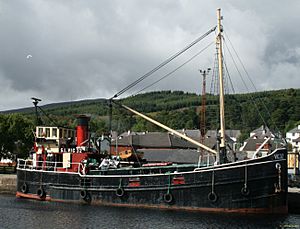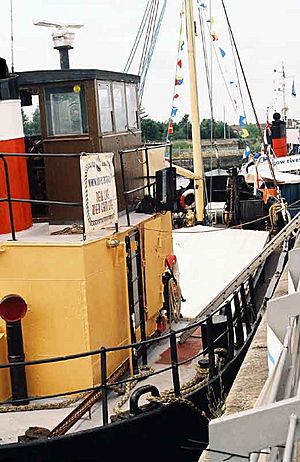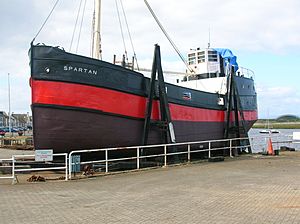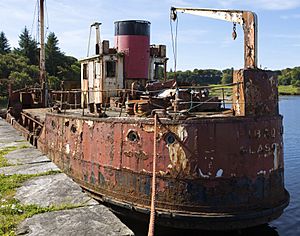Clyde puffer facts for kids

A Clyde puffer was a special kind of small cargo ship. These ships were powered by steam and had one mast. They were mostly built along the Forth and Clyde Canal in Scotland. Puffers were super important for carrying supplies to places along the west coast and the Hebrides islands of Scotland.
These sturdy little steamboats were built between 1856 and 1939. They became very famous thanks to stories written by Neil Munro. His stories were about a puffer called the Vital Spark and her captain, Para Handy. These stories were so popular they even became three TV series!
Contents
What Did Clyde Puffers Look Like?

Clyde puffers had a very distinct look. Their front (called the bow) was blunt and rounded. The crew's sleeping area, with a table and stove, was at the front of the ship. A single mast with a crane (called a derrick) stood in front of a big storage area for cargo.
The ship's funnel (smokestack) and steering wheel were at the back, above the engine room. Behind that was a small cabin for the captain. At first, the steering wheel was out in the open. But later, a wheelhouse was added behind the funnel. This gave puffers their famous look.
Their flat bottom was very useful. It allowed them to sit on the seabed at low tide. This was key for unloading goods in remote villages that didn't have proper docks. They often carried coal and furniture. On the way back, they might bring farm goods or gravel.
The History of These Handy Ships
Puffers grew out of older sailing barges called "gabberts." These barges handled most of the coastal trade. The very first puffer was named the Thomas, built in 1856. It was an iron canal boat. It was less than 66 feet (20 meters) long so it could fit through the locks on the Forth and Clyde Canal.
It had a simple steam engine. This engine let out steam into the funnel in puffs as it worked. This created both a visual puff of steam and a unique puffing sound. That's how they got the name "puffer"!
By the 1870s, similar boats were used outside the canal. These newer boats had condensers, so they didn't "puff" anymore. But the name stuck! A crane (derrick) was added to the mast to help lift cargo.
Different Types of Puffers
Three main types of puffers developed:
- Inside boats stayed on the Forth and Clyde canal.
- Shorehead boats traveled further. They went east into the Firth of Forth and west to the Isle of Bute and Loch Fyne. These boats were also kept at 66 feet long to fit the canal locks. Both these types had a crew of three.
- Outside boats were built for the rougher seas around the Hebrides islands. They had a crew of four and were longer, about 88 feet (27 meters). This length still allowed them to use the larger locks on the Crinan Canal.
More than 20 companies in Scotland built puffers. Many were along the Forth and Clyde canal in places like Kirkintilloch and Maryhill, Glasgow.
Puffers in Wartime
During World War I, these small ships proved very useful. They helped supply warships. In World War II, the British Navy ordered many steamships based on the puffer design. These were called VICs, which stood for "Victualling Inshore Craft". Many VICs later became cargo ships after the war.
Over time, engines changed. The Innisgara got an internal combustion engine in 1912. After World War II, new puffers started using diesel engines. Some VICs were even changed to run on diesel. The company that served the islands, Glenlight Shipping, stopped its service in 1993. This was because they couldn't compete with road transport using ferries.
Clyde Puffers in Stories and TV
The short stories by Neil Munro first appeared in the Glasgow Evening News in 1905. They became very popular and were published in books. These tales are still printed today.
Because of the stories, puffers became famous. They appeared in the movie The Maggie. And Para Handy and his Vital Spark were featured in three popular BBC television series. These shows ran from 1959 to 1995.
Surviving Clyde Puffers Today
A few puffers still exist today as special projects. Most of them now have diesel engines.
VIC 32 This is one of the very last coal-fired steam puffers left. It is based at The Change House, Crinan. It was built in 1943. During the war, the Navy needed many supply boats quickly. So, they built puffers in groups at different shipyards.
Since 1979, people have been able to take steam trips on VIC 32. It now offers cruises on the Caledonian Canal. From 2004, it had a big repair job. This was paid for by donations and lottery money. After getting a new boiler, it sailed to Crinan. Cruises on the Caledonian Canal have started again.
Vic 56 was built in 1945. It is kept in working condition at Chatham Historic Dockyard. It often steams along the Thames and Medway rivers.

Vic 96 was built in 1945. It was fixed up in Maryport and still has its original steam engine, boiler, and winch. In 2009, VIC 96 sailed 1,000 miles to its new home at Chatham. This journey took five weeks.
VIC 27 was renamed Auld Reekie. It starred as the Vital Spark in the third BBC TV Para Handy series. It sat at Crinan Basin for 14 years and got quite old. A museum owner bought it in 2006 and started repairs. It has since been sold to a new owner who is continuing the big restoration work. It is the oldest surviving steam-powered puffer and is an important part of Scotland's history.
VIC 72, renamed Eilean Eisdeal, was the last working "puffer" until the mid-1990s. In 2006, it was renamed Vital Spark of Glasgow. This was in honor of Neil Munro's Para Handy stories. You can visit it at the Inveraray Maritime Museum. It also still makes sailing trips.
The Spartan, another diesel-engined "puffer", is on display at the Scottish Maritime Museum in Irvine. The Spartan has recently had its hull repaired and is still being refitted. The museum also has the MV Kyles, an early cargo ship built on the Clyde.
The Pibroch (vessel)|Pibroch was built in Bowling, West Dunbartonshire in 1957. It was a diesel-engined boat. It sat in Letterfrack, County Galway, Ireland, needing repairs since 2002. The Pibroch got worse over time. In 2010, it was sold and then taken apart for scrap. A sister ship, the Julia T., lies underwater in Killary Bay.
Smaller replica puffers have also been built. One of the most recent is the MV Mary Hill. It is used for tourist trips on the Forth and Clyde canal.
|




